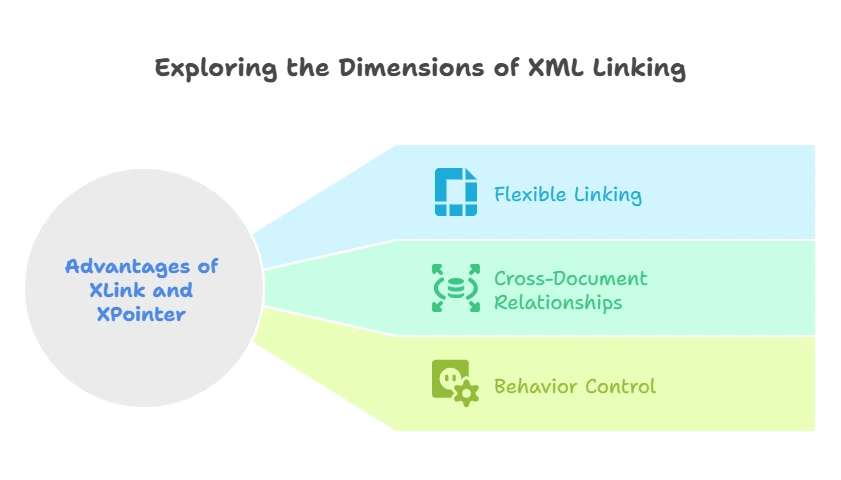Creating Links between XML Documents
XML (eXtensible Markup Language) is widely used for storing and transmitting data across platforms. However, just like HTML, XML also allows linking between documents and resources, but with more flexibility and sophistication. Linking XML documents is crucial in situations where data is distributed across multiple files or systems. Unlike HTML’s simple href attributes, XML employs various techniques for linking, such as XLink and XPointer, which provide a richer and more powerful set of linking mechanisms.
Basic Linking in XML
Although XML doesn’t inherently provide a built-in mechanism for linking like HTML’s <a> tag, we can still create simple references between XML documents using attributes. Here, we utilize plain text or URIs as references between documents. This can be done by defining a URI in a custom attribute and then linking to another XML document.
Example of Basic Linking
<books>
<book id="1" title="XML Fundamentals" author="John Doe" />
<book id="2" title="Advanced XML" author="Jane Smith" />
</books>
If the data about the authors is stored in another XML file:
<authors>
<author id="1" name="John Doe" uri="authors.xml#john_doe" />
<author id="2" name="Jane Smith" uri="authors.xml#jane_smith" />
</authors>
In this basic example:
- The
uriattribute holds the location of another document or data source. - It uses a URI fragment identifier (e.g.,
#john_doe) that refers to specific data in the authors document.
XLink: Extending Linking Capabilities in XML
XLink (XML Linking Language) is an advanced linking mechanism in XML that provides greater flexibility than the basic linking approach. It allows you to define simple links (like HTML <a> tags), as well as complex and extended links, such as those between multiple resources.
Simple XLink
A simple XLink is comparable to HTML’s hyperlink (<a> tag). Here, the xlink:href attribute is used to link to another document or resource.
<book xmlns:xlink="http://www.w3.org/1999/xlink" title="XML Guide">
<author xlink:type="simple" xlink:href="authors.xml#john_doe">John Doe</author>
</book>
xlink:type="simple"indicates this is a simple link.xlink:hrefpoints to the resource being linked, in this case,authors.xml#john_doe.
Extended XLink
Extended XLink allows multiple documents or resources to be linked together, offering a more sophisticated way of interlinking documents.
<books xmlns:xlink="http://www.w3.org/1999/xlink">
<book xlink:type="extended">
<title>XML for Beginners</title>
<link xlink:type="simple" xlink:href="authors.xml#john_doe">Author: John Doe</link>
<link xlink:type="simple" xlink:href="reviews.xml#book_review">Read Reviews</link>
</book>
</books>
In this example, the book element uses xlink:type="extended" to define multiple links within one context, connecting to an author and a review.
XPointer: Pointing to Specific Sections of XML Documents
While XLink defines relationships between XML resources, XPointer (XML Pointer Language) allows you to point to specific parts or fragments within those XML documents. XPointer is typically used in conjunction with XLink to link to specific elements, attributes, or text within an XML document.
XPointer Syntax
XPointer can point to different parts of an XML document, such as:
- By element name
- By element ID
- By specific locations within the document
Linking to an Element by ID
<book xmlns:xlink="http://www.w3.org/1999/xlink">
<link xlink:type="simple" xlink:href="authors.xml#xpointer(id('john_doe'))">John Doe</link>
</book>
In this case, the xlink:href attribute uses XPointer to link to the element in authors.xml with the ID john_doe.
Linking to a Specific Location in a Document
<book xmlns:xlink="http://www.w3.org/1999/xlink">
<link xlink:type="simple" xlink:href="authors.xml#xpointer(/authors/author[1])">First Author</link>
</book>
Here, XPointer points to the first author element in the authors.xml document using an XPath-like syntax.
Linking Multiple Resources
One of the most powerful features of XLink and XPointer is the ability to link multiple resources together. This is particularly useful when you need to interconnect different data sources.
Example: Linking Books, Authors, and Reviews
<books xmlns:xlink="http://www.w3.org/1999/xlink">
<book xlink:type="extended">
<title>Learning XML</title>
<link xlink:type="simple" xlink:href="authors.xml#xpointer(id('jane_smith'))">Author: Jane Smith</link>
<link xlink:type="simple" xlink:href="reviews.xml#xpointer(/reviews/review[1])">Review 1</link>
<link xlink:type="simple" xlink:href="reviews.xml#xpointer(/reviews/review[2])">Review 2</link>
</book>
</books>
In this example:
- We link the book to its author and to multiple reviews using XLink and XPointer.
Behavior Control in XLink
In XLink, attributes like xlink:show and xlink:actuate can control the behavior of linked resources. These attributes allow you to specify when and how a link should be activated and displayed.
xlink
The xlink:show attribute defines how the linked resource should be displayed. Possible values are:
- new: Opens the link in a new window.
- replace: Replaces the current document with the linked document.
- embed: Embeds the linked document in the current document.
<book xmlns:xlink="http://www.w3.org/1999/xlink">
<link xlink:type="simple" xlink:href="reviews.xml#xpointer(/reviews/review[1])" xlink:show="new">Read Review</link>
</book>
Here, the xlink:show="new" attribute opens the link in a new window or context.
xlink
The xlink:actuate attribute controls when the link should be activated. Possible values are:
- onRequest: The link is activated only when the user requests it.
- auto: The link is activated automatically when the document is loaded.
<book xmlns:xlink="http://www.w3.org/1999/xlink">
<link xlink:type="simple" xlink:href="authors.xml#xpointer(id('john_doe'))" xlink:actuate="auto">John Doe</link>
</book>
In this example, the link is automatically activated when the document is loaded.
Advantages of XLink and XPointer in XML Linking
- Flexible Linking: XLink and XPointer allow linking between different XML documents and even specific parts of those documents.
- Cross-Document Relationships: You can easily create relationships between documents in different locations, enhancing data structure and accessibility.
- Behavior Control: With attributes like
xlink:showandxlink:actuate, you can control when and how the linked resources are accessed.
Linking between XML documents using XLink and XPointer provides a powerful way to interconnect data across different sources. By mastering these techniques, you can create complex, flexible, and meaningful relationships between XML documents, enriching both the user experience and data accessibility. Happy Coding!❤️

